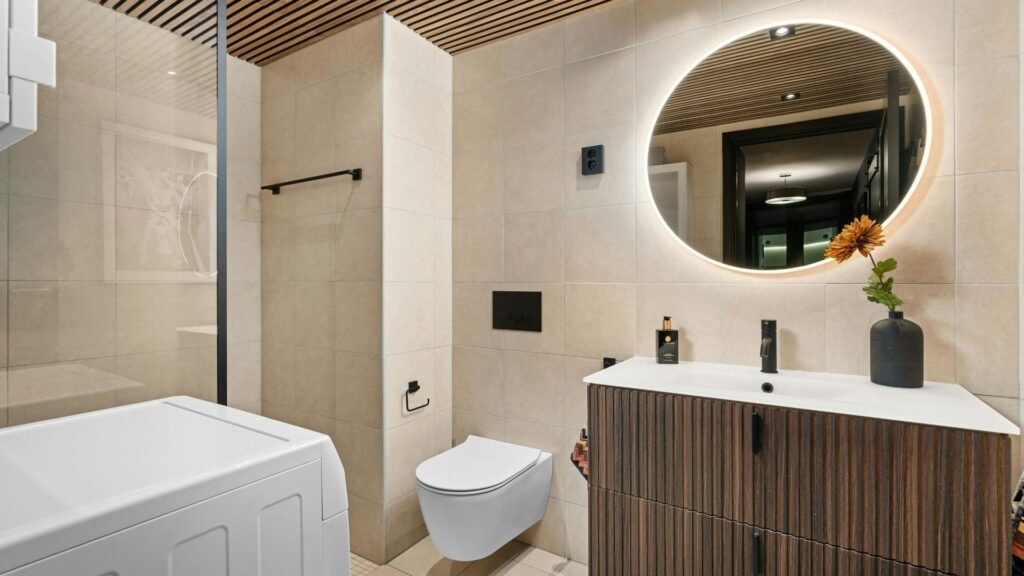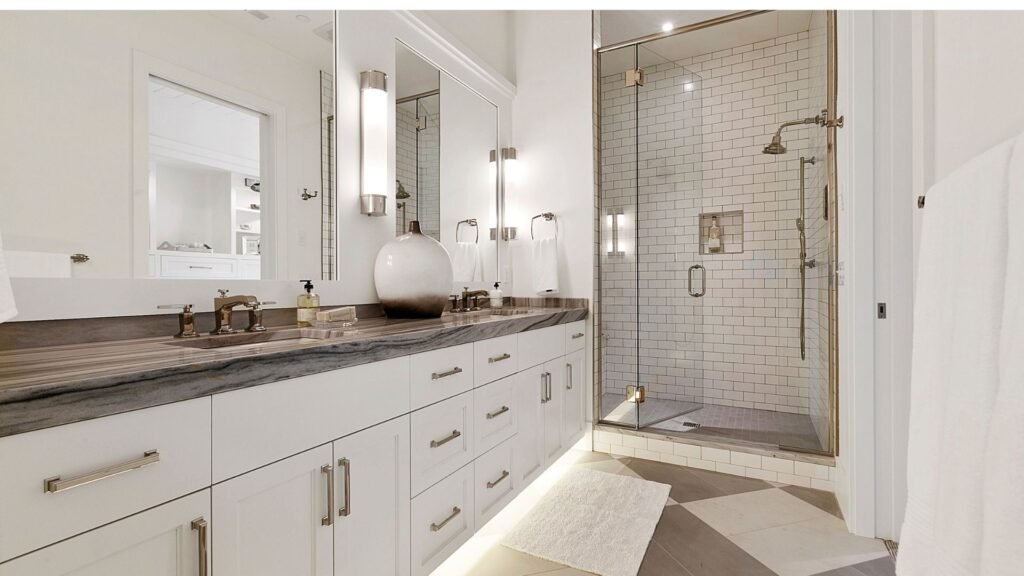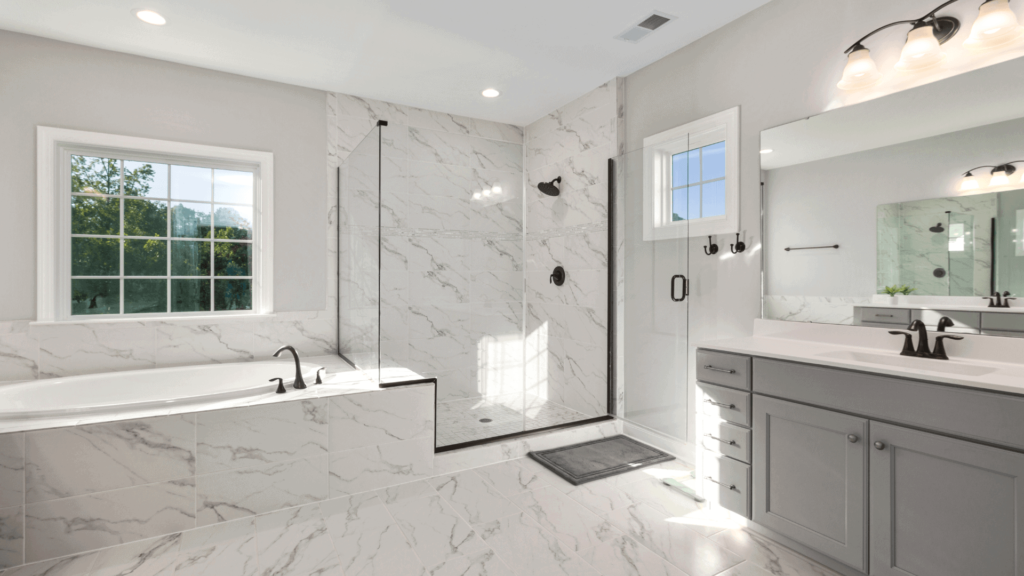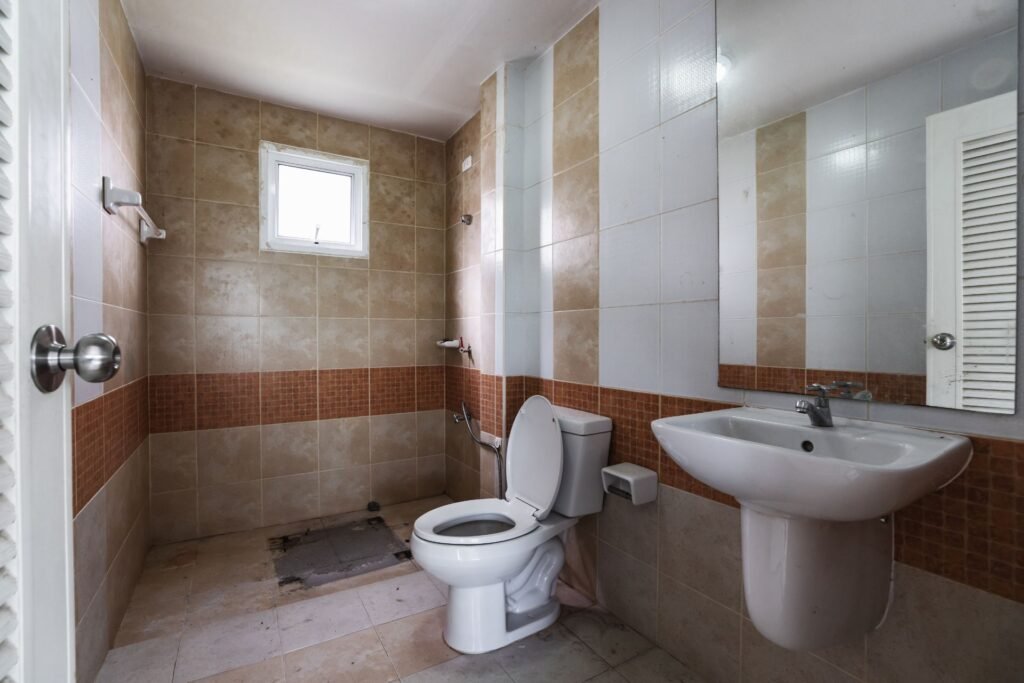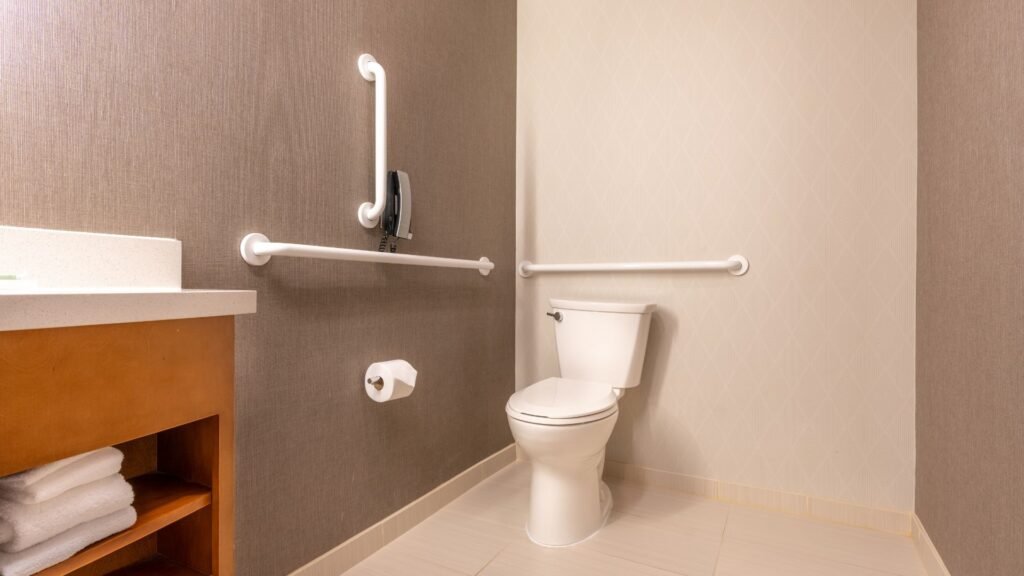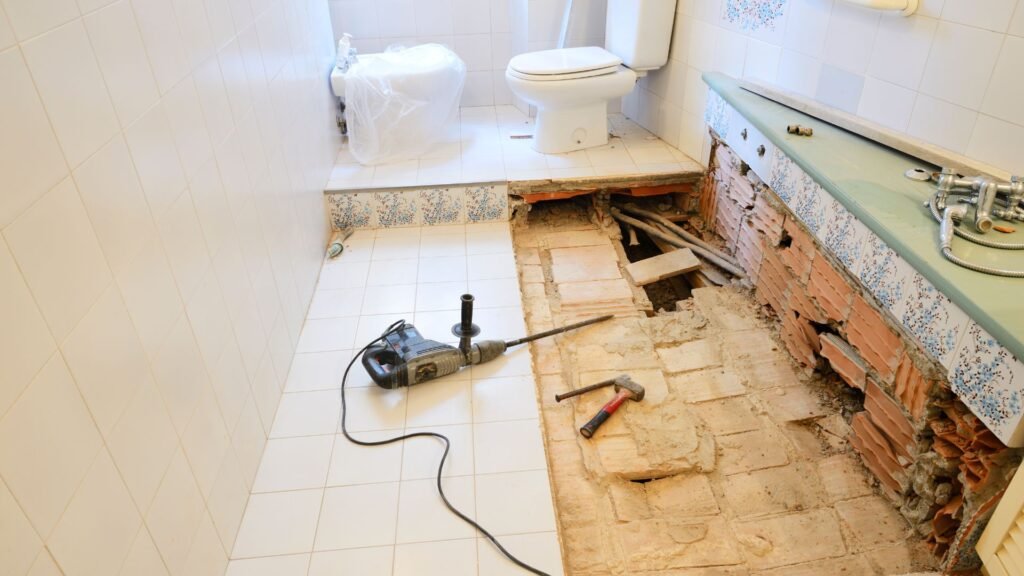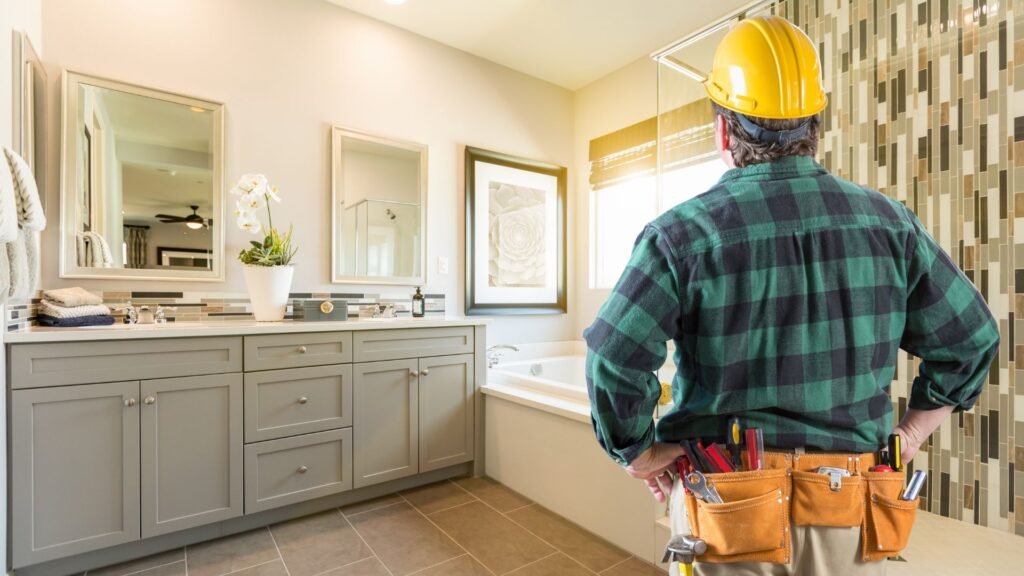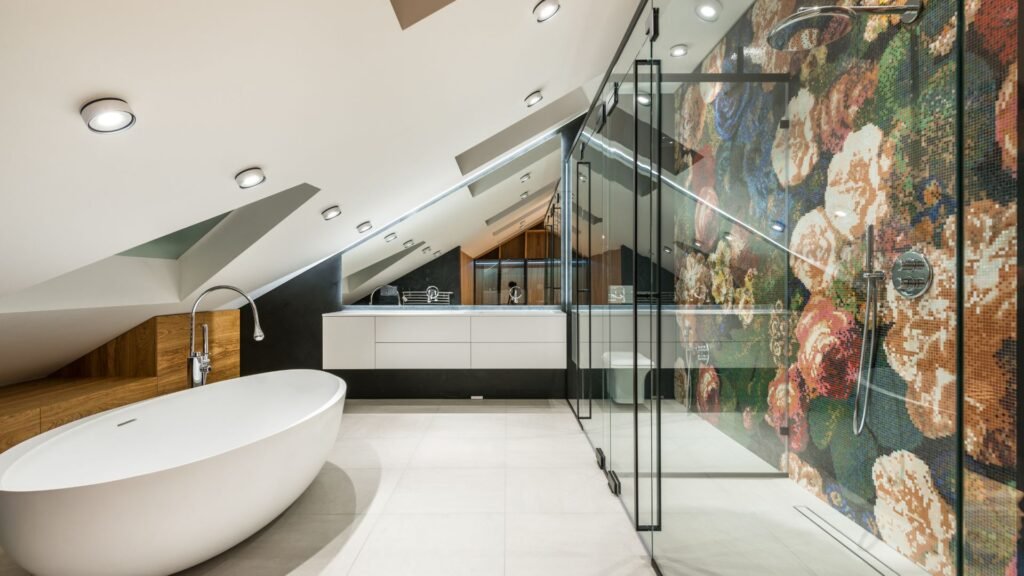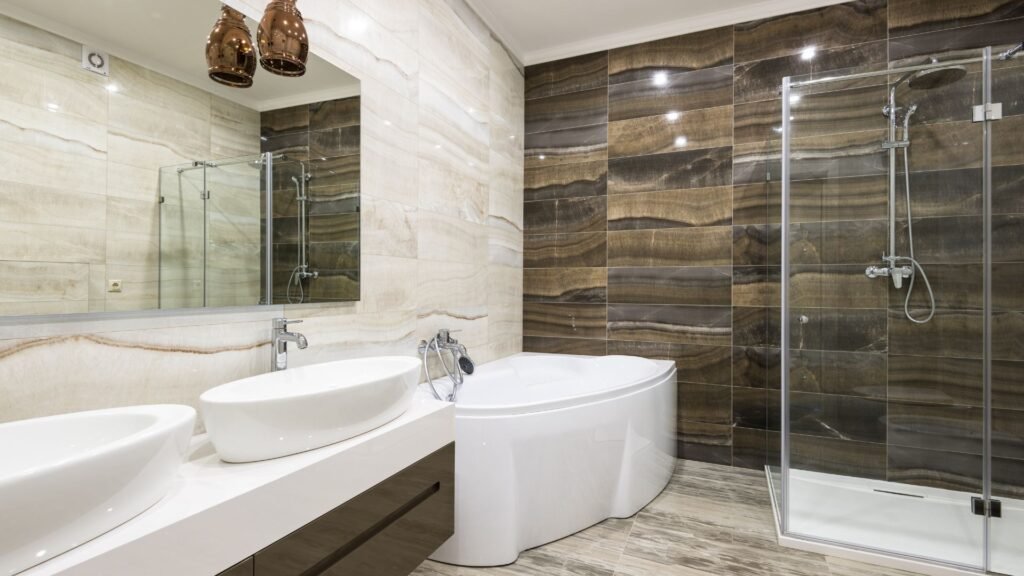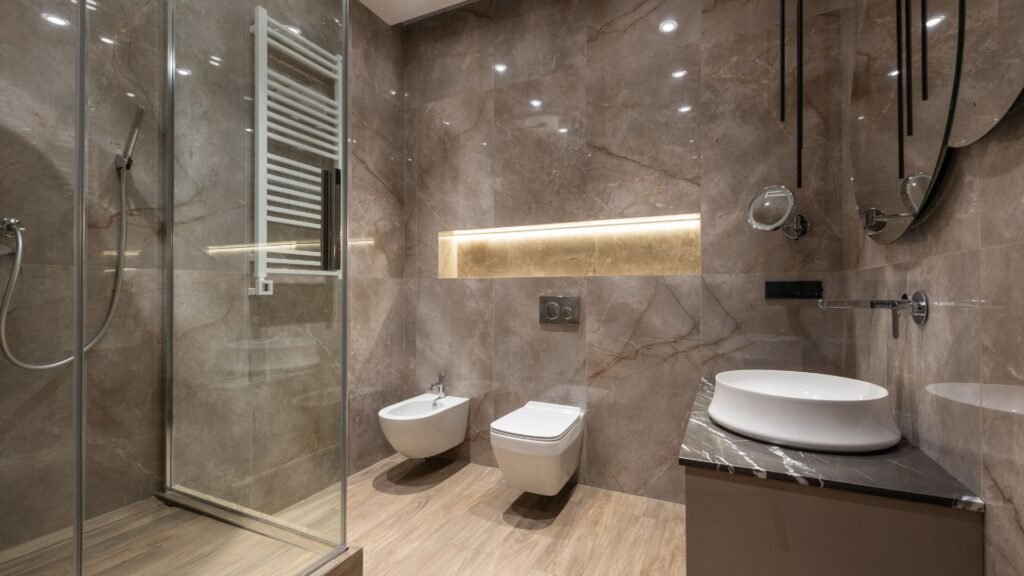Welcome to your go-to guide for budget-friendly bathroom renovations. If you’ve been asking yourself, “Can I renovate my bathroom for $10,000?”—you’re not alone. Many homeowners want to refresh their space without draining their savings. The good news? A $10K budget can go a long way with smart planning, clear priorities, and the right expectations. This post will break down what you can realistically achieve, where your money should go, and how to avoid common budget traps—so you can create a bathroom that looks great and works even better.
Yes, you can renovate your bathroom for $10,000 by focusing on cosmetic upgrades, reusing your existing layout, and choosing cost-effective materials. A $10K budget typically covers new fixtures, tile, paint, and minor plumbing or electrical work, making it ideal for small to mid-range remodels.
- Is $10,000 A Realistic Bathroom Renovation Budget?
- Breaking Down A $10,000 Bathroom Renovation Budget
- Where To Save Vs. Where To Spend
- DIY Vs. Hiring Pros: What’s Worth Doing Yourself?
- Real Homeowner Examples
- Tips To Stay On Budget
- Hidden Costs To Watch Out For
- Tools And Resources
- FAQs: About Can I Renovate My Bathroom For $10,000?
- Can I really renovate a bathroom for $10,000?
- What type of bathroom remodel can $10,000 cover?
- How can I cut costs during a bathroom renovation?
- What should I prioritize in a $10,000 renovation?
- Can I include a new bathtub or walk-in shower within budget?
- Is it better to DIY or hire professionals?
- Are permits required for a $10,000 bathroom renovation?
- How long does a $10,000 bathroom renovation take?
- What hidden costs should I plan for?
- What’s the biggest mistake to avoid on a $10,000 budget?
- Conclusion
Is $10,000 A Realistic Bathroom Renovation Budget?
Renovating a bathroom on a $10,000 budget is realistic, but it depends on your expectations, goals, and how you manage the costs. For many homeowners, this amount falls within the “small to mid-range” category, making it possible to upgrade function and style without breaking the bank.
Typical Bathroom Renovation Cost Ranges
Understanding the general cost breakdown helps set realistic expectations:
- Small Renovation ($5,000–$10,000):
Best for cosmetic upgrades, minor replacements, and partial remodeling. This is where your $10K budget fits. - Mid-Range Renovation ($10,000–$25,000):
Allows for better finishes, more fixture changes, and minor structural or layout updates. - High-End Renovation (Above $25,000):
Covers full gut renovations, luxury materials, custom features, and complete layout changes.
If your goal is to refresh your bathroom without moving walls or plumbing, a $10K budget can go a long way.
What $10,000 Typically Covers
With careful planning, a $10,000 budget can handle several meaningful updates:
- Minor Layout Adjustments:
Moving a vanity a few inches or updating a corner shower without relocating plumbing lines. - New Fixtures:
Swapping out the toilet, sink, vanity, and faucets for clean, modern replacements. - Fresh Paint and Drywall Work:
Repainting walls, repairing small sections of drywall, and brightening the space. - Tile Upgrades:
Installing new ceramic or porcelain tile on the floor or in the shower area. Opt for affordable yet durable options to stay on budget. - Lighting and Mirror Replacements:
Adding energy-efficient lighting and new mirrors to modernize the look without high costs.
These changes can make the bathroom look new and feel more functional without stretching your budget too far.
What $10,000 Likely Won’t Cover
To stay within budget, you’ll need to avoid high-ticket changes:
- Full Layout Changes:
Moving toilets, showers, or tubs involves major plumbing work, permits, and inspections—all of which raise costs significantly. - Luxury Finishes:
Marble countertops, designer tiles, heated floors, or custom cabinetry usually fall outside the $10K range. - Structural or Plumbing Relocations:
If your renovation involves rerouting pipes, tearing down walls, or reinforcing flooring, expect higher labor and materials costs.
Yes, you can renovate a bathroom for $10,000 if you focus on cosmetic changes and essential upgrades. Set clear priorities, choose materials wisely, and work with professionals where needed. If you avoid unnecessary layout changes, you’ll be able to transform your bathroom without overspending.

Breaking Down A $10,000 Bathroom Renovation Budget
When planning a bathroom renovation on a $10,000 budget, the key is to manage expectations and allocate costs wisely. You won’t be building a luxury spa, but you can create a functional and attractive space that adds value to your home. Below is a realistic cost breakdown that shows where your money is likely to go and how each part contributes to the full project.
This breakdown is based on average costs in most areas and is meant for a standard 5×8 or 6×10 bathroom remodel. Every dollar counts, so it’s important to know where to spend and where to save.
Demolition And Prep: $500–$1,000
Before anything new goes in, the old has to come out. Demolition includes removing tiles, fixtures, vanities, and sometimes drywall. You can save here by doing some of the demo work yourself, as long as you’re careful and avoid damaging plumbing or electrical lines. The prep stage may also include minor repairs to walls, subflooring, or plumbing access.
Plumbing And Electrical: $1,000–$1,500
Plumbing and electrical work should be left to licensed professionals. This cost range covers minor upgrades like updating fixtures, replacing valves, adding outlets, or installing better lighting. Moving plumbing (like relocating a toilet or shower) will cost significantly more and is not recommended on this budget. To stay on track, keep the original layout intact.
Vanity, Sink, And Toilet: $1,500–$2,000
This part of your budget goes toward essential fixtures. You can find quality vanities and sinks at big-box stores or online for less than $1,000. A standard toilet typically costs between $150 and $400. Choose functional, water-efficient models with durable finishes over high-end designer brands to stay within range.
Shower Or Tub: $1,500–$2,500
This is one of the most expensive parts of the remodel. A prefabricated shower unit or basic bathtub with a new surround keeps costs down. Custom tile work or luxury fixtures can push this over budget, so opt for quality materials that are easy to install and maintain. Replacing an existing tub with a similar one can help avoid extra plumbing costs.
Flooring And Tile: $1,000–$1,500
Flooring costs depend on the material you choose. Ceramic or porcelain tiles are popular choices for their durability and price. Vinyl or laminate flooring can offer savings, especially if you install it yourself. Keep patterns simple to reduce labor costs. For walls, you can mix paint and tile to keep expenses low.
Paint And Drywall: $500
Once your surfaces are up, you’ll need to patch or replace drywall and apply a fresh coat of paint. Moisture-resistant drywall may be required near wet areas. Choose a mold-resistant, bathroom-specific paint to ensure long-term protection. This is a great area to DIY and cut labor costs.
Labor: $2,000–$3,000
Labor can account for 30% or more of your total budget. This includes hiring contractors, plumbers, electricians, and tile installers. You can save by managing the project yourself and hiring specialists only where needed. Always get written quotes and check references before signing any contracts.
Contingency Fund: $500–$1,000
Unexpected issues come up often—hidden water damage, mold, or outdated wiring. A contingency fund prevents surprises from wrecking your budget. Set aside at least 5% to 10% of your total renovation cost for these unplanned expenses.
A $10,000 bathroom remodel is achievable with proper planning and smart choices. This breakdown helps you focus your spending where it matters and avoid unnecessary upgrades. By sticking to a clear budget and prioritizing essential upgrades, you’ll finish with a bathroom that looks great, works well, and doesn’t stretch your finances.

Where To Save Vs. Where To Spend
Renovating your bathroom on a $10,000 budget means making smart choices. You need to know when to cut costs—and when to invest. If you try to spend evenly across every item, you’ll either blow your budget or end up with low-quality results. This section breaks down where you can safely save money and where you shouldn’t compromise. These tips help you stretch your dollars while still getting a bathroom that looks good and works well for years.
Save: Focus On Looks Without Sacrificing Function
Reuse Layout
One of the most effective ways to save money is by keeping the existing layout. Moving plumbing for a new toilet, sink, or shower configuration can cost thousands. By leaving the sink, tub, and toilet in place, you avoid needing new plumbing lines, permits, and labor—huge savings with no visual downgrade.
Choose Prefabricated Vanities
Custom vanities may look appealing, but they often come with high price tags and longer lead times. A prefabricated vanity from a reputable home store can offer solid design, decent quality, and storage at half the cost. Many even come with a sink and countertop included.
Use Ceramic Tile Instead Of Natural Stone
Natural stone looks luxurious but is expensive to buy and install. Ceramic tiles are more affordable, widely available, and still offer attractive finishes. You can even find ceramic tile that mimics the look of marble or slate without the extra cost or maintenance.
Paint Instead Of Tile For Some Walls
Tiling every wall in a bathroom isn’t necessary. Save money by using high-quality, mold-resistant paint for dry areas. Reserve tile for the shower, tub surround, or backsplash. This approach still looks clean and modern while reducing material and labor costs.
Spend: Invest In What Affects Durability And Comfort
Plumbing Or Waterproofing
These are the areas where you don’t want to cut corners. Poor plumbing or waterproofing can lead to leaks, mold, or even structural damage down the line. Hire licensed professionals, use quality materials, and ensure everything is done to code. It’s not exciting—but it’s critical.
Shower/Tub Quality
You use your shower or tub every day. A cheap unit may crack, stain, or leak within a few years. Spend extra on a reliable brand with strong reviews. If possible, choose models with good warranties. A quality tub or shower also increases resale value.
Good Lighting
Lighting affects the mood and function of your bathroom. Dim or uneven light can make tasks like shaving or makeup application frustrating. Invest in layered lighting—ceiling lights for general use, vanity lighting for the mirror, and perhaps a small fixture over the shower. LED options are energy-efficient and long-lasting.
Making the right decisions on where to spend and where to save lets you get the most from your $10,000 budget. By keeping the layout, choosing budget-friendly finishes, and putting money into plumbing, lighting, and your main fixtures, you get a bathroom that feels new, works well, and lasts—without overspending.

DIY Vs. Hiring Pros: What’s Worth Doing Yourself?
If you’re working with a $10,000 bathroom renovation budget, one of the biggest decisions you’ll face is whether to do the work yourself or hire professionals. This choice impacts your costs, timeline, and final results. The key is knowing what you can handle confidently and what’s better left to trained experts.
What You Can Do Yourself
There are several tasks in a bathroom remodel that most homeowners can tackle with basic tools, some research, and a bit of patience:
- Painting: Painting walls, ceilings, or even cabinets is one of the easiest ways to freshen up your space. With the right prep work and quality paint, you can save hundreds.
- Demolition: Removing old fixtures, tiles, or flooring doesn’t require a contractor. Wear protective gear, and take your time to avoid damaging anything you plan to keep.
- Installing Hardware: You can easily install towel bars, mirrors, shelves, or light switch plates. These small details finish the space and don’t require a pro.
Doing these tasks yourself can cut down labor costs and give you more flexibility in your budget for higher-ticket items.
What You Should Leave To Professionals
While DIY can save you money, some tasks demand experience and should be left to licensed professionals:
- Plumbing: Moving or replacing plumbing fixtures like sinks, toilets, or showers must be done correctly. A mistake can lead to leaks, water damage, and expensive repairs later.
- Electrical Work: Any work involving wiring, new outlets, or lighting should be handled by a qualified electrician. Safety regulations are strict, and doing it wrong can be dangerous.
- Waterproofing: Bathrooms deal with constant moisture. Improper waterproofing around tubs, showers, or floors can lead to mold, rot, and structural damage. Always hire a pro for this.
Letting experts handle these complex tasks protects your home and ensures everything meets code.
Time Vs. Money Trade-Off
Doing things yourself can save money, but it often takes more time—especially if you’re learning as you go. Professionals work faster and deliver results that last longer. You’ll need to balance how much free time you have against how much you’re willing to spend.
If you only have weekends or evenings to work, your project may stretch over weeks or months. Hiring pros might cost more up front, but it shortens the timeline and reduces stress.
Tip: Mix DIY And Pro Work To Stay On Budget
One of the smartest strategies is to combine both approaches. Handle easy, cosmetic updates on your own, and use your budget to pay professionals for the critical parts. This hybrid model keeps your costs under control without sacrificing quality or safety.
For example, you might:
- Remove the old vanity and flooring yourself
- Paint the walls and install towel bars
- Hire a plumber for the new sink and toilet
- Bring in a tile expert for the shower area
This balance gives you hands-on control while ensuring the important work is done right the first time.
A successful $10,000 bathroom renovation isn’t just about cutting costs—it’s about making smart decisions. Knowing when to roll up your sleeves and when to bring in a pro can make or break your project.

Real Homeowner Examples
Understanding what’s possible with a $10,000 bathroom renovation budget becomes easier when you see how real homeowners made it work. Below are two case studies that show different approaches—one that stayed under budget and one that ran slightly over. These examples provide practical insights you can learn from before starting your own project.
Case Study 1: $9,800 Bathroom Renovation – On Budget and On Point
Sarah and James from Ohio wanted to refresh their 20-year-old guest bathroom without overspending. Their goal was simple: modernize the space, make it feel clean and updated, and avoid moving any plumbing.
What they did right:
- Kept the layout the same – This helped them avoid expensive plumbing changes.
- Shopped smart – They bought a prefabricated vanity on sale and scored a discounted mirror and lighting fixture from a clearance section.
- Did some of the work themselves – They handled demolition and painting, which saved over $1,000 in labor costs.
- Chose durable, affordable materials – They went with ceramic tile for the floor and a fiberglass tub/shower combo that looked clean but didn’t break the bank.
What they would change:
- “We wish we’d spent a bit more on the vanity faucet,” Sarah said. “The one we chose looks good but doesn’t feel very solid.”
Their total cost: $9,800. The result? A bright, fresh bathroom with improved lighting, better storage, and a clean new look—done without going over budget.
Case Study 2: $10,500 Bathroom Renovation – Slightly Over, Still Satisfied
Mike from Arizona started his bathroom remodel with a $10,000 target. But during demolition, his contractor discovered a leaking pipe behind the wall, which had been slowly causing damage to the subfloor. That alone added an extra $500 to the project.
What he did right:
- Hired a licensed plumber from the start – This helped catch the issue early and prevent a much larger problem later.
- Invested in waterproof flooring and a higher-end shower system – He prioritized features that added real value and comfort to the space.
- Took the time to get multiple quotes – By comparing pricing, he avoided overpaying for labor and materials.
What he would change:
- “I underestimated the importance of having a 10–15% buffer,” Mike said. “If I had planned for it, the extra cost wouldn’t have felt like a surprise.”
His final cost: $10,500. The bathroom turned out modern, functional, and much more appealing than before. Even with the added expense, Mike felt it was worth it.
Key Takeaways From Both Projects
- Stick to your layout unless you’re prepared to increase the budget.
- Expect surprises—especially in older homes.
- Mix DIY with professional help when you can.
- Leave room in your budget for unexpected costs.
- Choose materials that balance style and practicality.
By learning from real homeowners, you can make smarter choices and reduce stress during your own renovation. These case studies show that yes—you can renovate a bathroom for around $10,000, but it takes planning, flexibility, and smart decision-making.
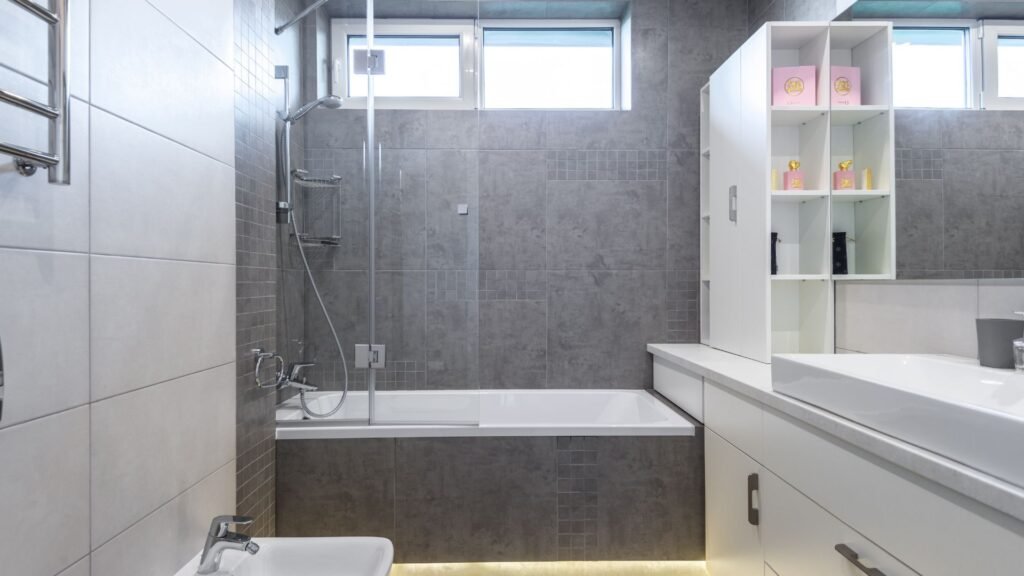
Tips To Stay On Budget
Renovating a bathroom can get expensive quickly, but there are practical ways to keep costs under control without cutting corners. If your goal is to complete the project within a $10,000 budget, these tips will help you make smarter decisions, avoid surprise costs, and get the most value out of every dollar.
Get 3+ Quotes
Before hiring a contractor or plumber, always get at least three detailed quotes. Pricing can vary a lot between professionals, even for the same type of work. By comparing quotes, you’ll not only understand the fair market rate but also spot red flags like vague estimates or unusually high costs. Make sure each quote includes labor, materials, timeline, and any extra fees. Don’t just go with the cheapest option—choose someone with clear communication, good reviews, and experience with bathroom remodels.
Use Stock Items Instead Of Custom
Custom vanities, cabinets, or shower doors look great, but they can quickly blow your budget. Stock options, available at most home improvement stores, are often half the cost and still offer style and durability. You can find stock vanities with quartz or stone tops, pre-built shelving, and modern fixtures that look high-end without the premium price tag. Save custom upgrades for areas that truly need them, or for future renovations.
Shop Sales And Clearance
Timing your purchases can make a big difference. Look for sales at big-box stores, online retailers, and local suppliers. End-of-season clearance, discontinued models, and overstock items can offer major savings on tiles, vanities, lighting, and faucets. Sign up for email alerts or loyalty programs to get early access to promotions. You can also check Facebook Marketplace or Habitat for Humanity ReStores for gently used or surplus materials at steep discounts.
Prioritize Needs Over Wants
It’s easy to get caught up in design trends and Pinterest boards, but if you’re on a strict budget, focus on function first. Make a list of must-haves—like a working toilet, a safe shower, and good lighting. Then list the nice-to-haves, such as heated floors or a rainfall showerhead. If you have leftover funds after covering the essentials, you can consider adding a few upgrades. Sticking to priorities will help prevent impulse buys and keep your budget intact.
Avoid Changing Plumbing Layout
One of the fastest ways to exceed your budget is by moving plumbing lines. Changing the location of your toilet, shower, or sink requires cutting into walls and floors, hiring a licensed plumber, and possibly getting permits. These changes also risk exposing hidden issues like old pipes or water damage. If your current layout works, keep it. You can still upgrade fixtures, tiles, and lighting without rearranging the entire room. Staying with the existing layout can save thousands of dollars and weeks of labor.
Sticking to these tips will help you stay in control of your bathroom renovation budget while still achieving a clean, updated look. Careful planning, smart purchases, and realistic expectations can go a long way in making your $10,000 stretch.

Hidden Costs To Watch Out For
Bathroom renovations can be full of surprises, especially when you’re working with a tight $10,000 budget. While you may plan every tile and fixture down to the last dollar, unexpected costs can creep in and throw off your entire estimate. Knowing what hidden expenses to look out for can help you stay in control and avoid overspending. Here are the four most common hidden costs homeowners face when remodeling a bathroom.
Water Damage
This is one of the most common issues discovered during a renovation. Once old tiles, drywall, or flooring are removed, it’s not unusual to uncover mold, rot, or water-stained subfloors. Even a small leak from an old toilet or shower over time can cause significant damage. Repairs can involve replacing drywall, insulation, or subflooring—and that adds labor and material costs that weren’t in your original plan. If you’re remodeling an older home or a bathroom with signs of previous leaks, be prepared to set aside a contingency fund of $500 to $1,000 just in case.
Old Plumbing Upgrades
Many bathrooms, especially in homes built over 30 years ago, still have outdated plumbing. Once you remove the vanity or open up the wall, your contractor might find corroded pipes, poor connections, or plumbing that’s no longer up to code. Replacing old pipes or rerouting lines—even slightly—can quickly increase your budget. In some cases, you may also need to upgrade drain sizes or water shutoff valves, which can involve opening up more walls or flooring.
Permit Fees
Depending on where you live and what your remodel includes, you may need permits for plumbing, electrical, or structural changes. These fees vary by city or county, but they can range from $100 to $500 or more. Failing to get the right permits could result in penalties, delays, or even being forced to redo the work. If your project involves major system changes, it’s best to check with your local building department ahead of time and include permit costs in your budget.
Delivery And Haul-Away Fees
Most homeowners focus on the cost of new materials, but forget about the cost of getting them to the site or disposing of the old ones. Delivery charges can apply to large items like vanities, bathtubs, or tile shipments, especially if ordered from specialty suppliers. On the flip side, hauling away construction debris, old tiles, drywall, or fixtures also costs money. Some contractors include this in their bid, while others bill it separately. Expect to pay $100 to $300, depending on how much needs to be removed.
Knowing these hidden costs can help you build a more realistic bathroom renovation plan. Set aside 10–15% of your budget for surprises. That way, you’re not caught off guard and can keep your project moving without compromise.

Tools And Resources
When you’re working with a $10,000 bathroom renovation budget, every dollar counts. The right tools and resources can help you stay on track, avoid overspending, and make smarter decisions throughout the project. Below are practical tools and platforms to help you manage your renovation from start to finish.
Budget Calculator
Using a bathroom renovation budget calculator helps you plan where your money will go before any work starts. It lets you break down costs for labor, materials, fixtures, and hidden fees like permit charges or plumbing repairs. This way, you can see if your design ideas fit within your $10K limit—or if you need to make adjustments. Look for calculators that let you enter your zip code to reflect local labor and material prices. You can find free options online from trusted sources like HomeAdvisor or remodeling blogs.
Project Planning Apps
Keeping your bathroom renovation organized is just as important as setting the right budget. Project planning apps like Trello, Notion, or even Google Sheets help you map out each step of the process—from selecting materials to hiring contractors. These tools let you:
- Create checklists for each stage
- Set deadlines
- Track your spending
- Save receipts and quotes in one place
Using an app also keeps everyone on the same page if you’re working with a designer or contractor. Instead of relying on memory or messy notes, everything is documented and easy to access.
Where To Find Deals
You don’t have to pay full price for bathroom materials or fixtures. Knowing where to find deals can save hundreds—or even thousands—on your total cost. Here are three great places to check:
- Home Depot: Offers frequent sales on vanities, toilets, faucets, and tile. Their clearance section is especially useful for discounted overstock items.
- Lowe’s: Similar to Home Depot, Lowe’s carries a wide range of affordable fixtures and finishes. Their online promotions and bulk discounts can help you stay within budget.
- Facebook Marketplace: A hidden gem for secondhand or surplus building materials. Many homeowners and contractors sell leftover items—like unused tiles, cabinets, or brand-new tubs—at a fraction of retail price.
Before you buy, always double-check measurements and product condition. With a little patience and good timing, you can find high-quality items without draining your budget.
Using the right tools and knowing where to shop can stretch your $10,000 much further than you’d expect. Planning smart saves money, time, and stress—so don’t skip this step.
Thinking about renovating your bathroom on a $10,000 budget? Visit Bathroom Renovation Christchurch to explore how we help homeowners plan smarter, save more, and get the most from every dollar.

FAQs: About Can I Renovate My Bathroom For $10,000?
Can I really renovate a bathroom for $10,000?
Yes, it’s possible to renovate a bathroom for $10,000, especially if you keep the layout the same, choose budget-friendly materials, and limit custom work. Focus on essentials like fixtures, tiles, and paint.
What type of bathroom remodel can $10,000 cover?
A $10,000 budget typically covers a mid-range remodel. That includes replacing the toilet, vanity, and tub or shower, new flooring, fresh paint, and minor plumbing or electrical work.
How can I cut costs during a bathroom renovation?
Stick with the existing layout, choose stock materials, do small tasks yourself (like demo or painting), shop sales, and avoid moving plumbing fixtures.
What should I prioritize in a $10,000 renovation?
Prioritize plumbing, waterproofing, and quality fixtures. Spend less on luxury finishes or non-essential upgrades and more on areas that impact function and longevity.
Can I include a new bathtub or walk-in shower within budget?
Yes, but choose prefabricated options rather than custom builds. A basic new tub or shower insert fits well within a $1,500–$2,500 range.
Is it better to DIY or hire professionals?
Mix both. You can save money by handling demo, painting, or hardware installation yourself. Hire professionals for plumbing, electrical, and waterproofing to avoid costly mistakes.
Are permits required for a $10,000 bathroom renovation?
Permits may be needed for plumbing or electrical work. Check with your local building authority to avoid fines or delays.
How long does a $10,000 bathroom renovation take?
Expect the project to take 2–4 weeks depending on the scope of work, contractor availability, and whether you’re doing any parts yourself.
What hidden costs should I plan for?
Plan for a contingency budget of 10–15% to cover surprises like water damage, outdated wiring, or structural issues behind walls.
What’s the biggest mistake to avoid on a $10,000 budget?
Changing the layout or moving plumbing lines. This adds major cost and complexity. Stick to the existing layout to keep costs predictable.
Conclusion
Yes, renovating a bathroom for $10,000 is doable—but only if you make smart choices from the start. Instead of chasing trends or high-end finishes, focus on what truly adds value to your space: functional upgrades, long-lasting materials, and well-thought-out planning. Small changes like updating tiles, swapping out fixtures, or applying a fresh coat of paint can dramatically improve the look and feel of your bathroom without pushing your budget. To make every dollar count, take the time to plan each step, research product options, and get multiple quotes from contractors or suppliers. This approach helps you avoid costly surprises and ensures your renovation stays on track—both financially and functionally.
About the Author:
Mike Veail is a recognized digital marketing expert with over 6 years of experience in helping tradespeople and small businesses thrive online. A former quantity surveyor, Mike combines deep industry knowledge with hands-on expertise in SEO and Google Ads. His marketing strategies are tailored to the specific needs of the trades sector, helping businesses increase visibility and generate more leads through proven, ethical methods.
Mike has successfully partnered with numerous companies, establishing a track record of delivering measurable results. His work has been featured across various platforms that showcase his expertise in lead generation and online marketing for the trades sector.
Learn more about Mike's experience and services at https://theleadguy.online or follow him on social media:

